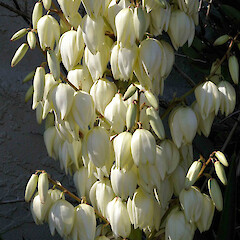Yucca gloriosa
Common name
Spanish dagger, palm lily, mound-lily yucca
Family
Asparagaceae
Flora category
Vascular – Exotic
Structural class
Herbs - Monocots
Conservation status
Not applicable
Habitat
Occur naturally on coastal dunes and shell mounds near the Atlantic, from North Carolina to north-east Florida.
Detailed description
An erect evergreen shrub with swordlike leaves about 5 cm wide and 0.6-0.9 m long originating from a basal rosette. The leaves are bluish or grayish green with smooth margins and pointed tips. They tend to bend near the middle and arch downward. In summer mound-lily yucca puts up a showy 6-8 ft (1.8-2.4 m) spike of fragrant flowers that are white with purplish tinges, pendant and about 7.6 cm across. Mound-lily yucca stays in a stemless rounded clump 2-5 ft (0.6-1.5 m) across and about the same height for several years, but eventually develops a trunk or stem which elevates that clump of leaves above the ground as much as 1.8-2.4 m. In older plants the stem develops branches and each terminus has its own rosette of leaves.
Similar taxa
The cultivar, Nobilis has dark green leaves and Variegata has leaves with yellow margins.
Flowering
Summer
Flower colours
Violet/Purple, White
Propagation technique
Seed and stem and root fragments.
Year naturalised
1970
Origin
N. America
Etymology
yucca: An name derived from a language in the Carib group, denoting another plant and mistakenly applied to this taxa.




